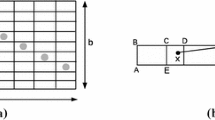Abstract
A random geometric graph (RGG) is defined by placing n points uniformly at random in [0,n 1/d]d, and joining two points by an edge whenever their Euclidean distance is at most some fixed r. We assume that r is larger than the critical value for the emergence of a connected component with Ω(n) nodes. We show that, with high probability (w.h.p.), for any two connected nodes with a Euclidean distance of \(\omega (\frac{\log n}{r^{d-1}} )\), their graph distance is only a constant factor larger than their Euclidean distance. This implies that the diameter of the largest connected component is Θ(n 1/d/r) w.h.p. We also prove that the condition on the Euclidean distance above is essentially tight.
We also analyze the following randomized broadcast algorithm on RGGs. At the beginning, only one node from the largest connected component of the RGG is informed. Then, in each round, each informed node chooses a neighbor independently and uniformly at random and informs it. We prove that w.h.p. this algorithm informs every node in the largest connected component of an RGG within Θ(n 1/d/r+logn) rounds.




Similar content being viewed by others
Notes
By “with high probability” (short: w.h.p.), we denote an event that holds with probability at least \(1-\mathcal{O}(n^{-1})\).
References
Akyildiz, I., Pompili, D., Melodia, T.: Underwater acoustic sensor networks: research challenges. Ad Hoc Netw. 3, 257–279 (2005)
Antal, P., Pisztora, A.: On the chemical distance for supercritical Bernoulli percolation. Ann. Probab. 24, 1036–1048 (1996)
Avin, C., Ercal, G.: On the cover time and mixing time of random geometric graphs. Theor. Comput. Sci. 380(1–2), 2–22 (2007)
Bradonjić, M., Elsässer, R., Friedrich, T., Sauerwald, T., Stauffer, A.: Efficient broadcast on random geometric graphs. In: 21st Annual ACM-SIAM Symposium on Discrete Algorithms (SODA’10), pp. 1412–1421 (2010)
Cooper, C., Frieze, A.: The cover time of the giant component of a random graph. Random Struct. Algorithms 32(4), 401–439 (2008)
Cooper, C., Frieze, A.: The cover time of random geometric graphs. In: 19th Annual ACM-SIAM Symposium on Discrete Algorithms (SODA’09), pp. 48–57 (2009)
Deuschel, J.-D., Pisztora, A.: Surface order large deviations for high-density percolation. Probab. Theory Relat. Fields 104, 467–482 (1996)
Ellis, R.B., Martin, J.L., Yan, C.: Random geometric graph diameter in the unit ball. Algorithmica 47(4), 421–438 (2007)
Elsässer, R., Sauerwald, T.: Broadcasting vs. mixing and information dissemination on Cayley graphs. In: 24th International Symposium on Theoretical Aspects of Computer Science (STACS’07), pp. 163–174 (2007)
Elsässer, R., Sauerwald, T.: On the runtime and robustness of randomized broadcasting. Theor. Comput. Sci. 410(36), 3414–3427 (2009)
Feige, U., Peleg, D., Raghavan, P., Upfal, E.: Randomized broadcast in networks. Random Struct. Algorithms 1(4), 447–460 (1990)
Fontes, L., Newman, C.: First passage percolation for random colorings of ℤd. Ann. Appl. Probab. 3(3), 746–762 (1993)
Fountoulakis, N., Panagiotou, K.: Rumor spreading on random regular graphs and expanders. In: 14th Inter. Workshop on Randomization and Comput. (RANDOM). LNCS, vol. 6302, pp. 560–573 (2010)
Frieze, A., Grimmett, G.: The shortest-path problem for graphs with random arc-lengths. Discrete Appl. Math. 10, 57–77 (1985)
Grimmett, G.: Percolation, 2nd edn. Springer, Berlin (1999)
Higham, D., Rašajski, M., Pržulj, N.: Fitting a geometric graph to a protein–protein interaction network. Bioinformatics 24(8), 1093 (2008)
Liggett, T., Schonmann, R., Stacey, A.: Domination by product measures. Ann. Probab. 25(1), 71–95 (1997)
Meester, R., Roy, R.: Continuum Percolation. Cambridge University Press, Cambridge (1996)
Muthukrishnan, S., Pandurangan, G.: The bin-covering technique for thresholding random geometric graph properties. J. Comput. Syst. Sci. 76, 686–696 (2010)
Ou, C.-H., Ssu, K.-F.: Sensor position determination with flying anchors in three-dimensional wireless sensor networks. IEEE Trans. Mob. Comput. 7, 1084–1097 (2008)
Penrose, M., Pisztora, A.: Large deviations for discrete and continuous percolation. Adv. Appl. Probab. 28, 29–52 (1996)
Penrose, M.D.: The longest edge of the random minimal spanning tree. Ann. Appl. Probab. 7(2), 340–361 (1997)
Penrose, M.D.: On k-connectivity for a geometric random graph. Random Struct. Algorithms 15(2), 145–164 (1999)
Penrose, M.D.: Random Geometric Graphs. Oxford University Press, Oxford (2003)
Pittel, B.: On spreading a rumor. SIAM J. Appl. Math. 47(1), 213–223 (1987)
Pottie, G.J., Kaiser, W.J.: Wireless integrated network sensors. Commun. ACM 43(5), 51–58 (2000)
Sauerwald, T.: On mixing and edge expansion properties in randomized broadcasting. Algorithmica 56, 51–88 (2010)
Author information
Authors and Affiliations
Corresponding author
Additional information
A conference version with slightly weaker results appeared in the 22nd International Symposium on Algorithms and Computation. This work was initiated while the first two authors were at the International Computer Science Institute Berkeley supported by the German Academic Exchange Service (DAAD) and the third author was at the Computer Science Division of the University of California Berkeley.
Appendix: Standard Large Deviation Results
Appendix: Standard Large Deviation Results
Lemma 21
(Chernoff bound for sums of geometric variables)
Let X 1,…,X n be independent geometric random variables, each having parameter p (and thus mean 1/p), and let \(X = \sum_{i=1}^{n} X_{i}\). Then, for any ϵ>0,
Rights and permissions
About this article
Cite this article
Friedrich, T., Sauerwald, T. & Stauffer, A. Diameter and Broadcast Time of Random Geometric Graphs in Arbitrary Dimensions. Algorithmica 67, 65–88 (2013). https://doi.org/10.1007/s00453-012-9710-y
Received:
Accepted:
Published:
Issue Date:
DOI: https://doi.org/10.1007/s00453-012-9710-y




